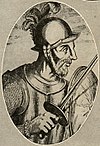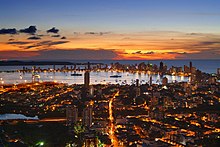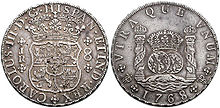History of Cartagena, Colombia
The Caribbean region, particularly in the area from the Sinú River delta to the Cartagena de Indias bay, appears to be the first documented human community in today's Colombia: the Puerto Hormiga Culture.
The primary reason for the proliferation of primitive societies in this area is the relative mildness of climate and the abundance of wildlife which through continuous hunting allowed the inhabitants a comfortable life.
[3][4][5] In today's villages of Maria La Baja, Sincerín, El Viso and Mahates and Rotinet, there have also been discoveries of the remains of culturally organized societies through the excavation of maloka-type buildings, which are directly related to the early Puerto Hormiga settlements.
The rise of a much more developed culture, the Monsú, who lived at the end of the Dique Canal, near today's Cartagena neighborhoods Pasacaballos and Ciénaga Honda at the northernmost part of Barú Island.
[6] The ethnologists who discovered Monsú, Gerardo Reichel-Dolmatoff and his wife Alicia Dussan, found an interesting artificial mound created by them consisting in vases and rests of skeletons.
These tribes, though physically and administratively separated, shared common architecture, such as hut structures consisting of circular rooms with tall roofs inside wooden palisades.
Bastidas explored the coast and discovered the Magdalena River delta in his first journey from Guajira to the south in 1527, trip that ended in the Urabá gulf, seat of the failed first settlements.
While Desjean only asked for 250,000 Spanish reales in ransom, Jean du Casse stayed a few months later and dishonored the promise of the Baron of respecting the churches and holy places and left them with nothing.
During the 17th century, the Spanish Crown hired the services of prominent European military engineers to carry out the construction of fortresses, which are nowadays one of Cartagena's clearest signs of identity.
It was built during the Governorship of Pedro Zapata de Mendoza, Marquis of Barajas, and was constructed to repel land attacks, equipped with sentry boxes, buildings for food and weapons storage, tunnels.
The first slaves arrived with Pedro de Heredia and they worked as cane cutters to open roads, in the desecration of tombs of the aboriginal population of Sinú, and in the construction of buildings and fortresses.
The agents of the Portuguese company Cacheu distributed human 'cargos' from Cartagena for mine exploitation in Venezuela, the West Indies, the Nuevo Reino de Granada and the Viceroyalty of Perú.
On 5 February 1610, the Catholic Monarchs established from Spain the Inquisition Holy Office Court in Cartagena de Indias by a Royal Decree issued by King Philip II.
The reconstruction after the Raid on Cartagena (1697) was initially slow, but with the ending of the War of the Spanish Succession around 1711 and the competent administration of D. Juan Diaz de Torrezar Pimienta the walls were rebuilt, the forts reorganized and restored and the public services and buildings reopened.
During the reign of Philip V of Spain the city had many new public works starting or ending like the new fort of San Fernando, the Hospital of the Obra Pía and the full paving of all the streets and the opening of new roads.
These good times of steady progress and advance of the second half of the 18th century came into an abrupt end in 1808, with the general crisis of the Spanish Empire, embodied in the Mutiny of Aranjuez, with all its consequences.




















